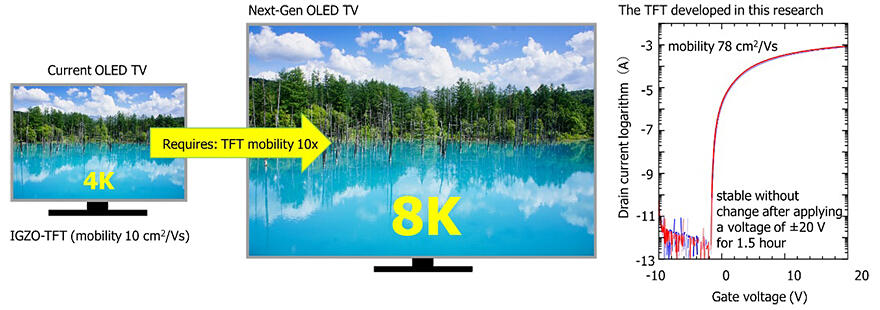A research group led by Assistant Professor Yusaku Magari and Professor Hiromichi Ohta of Research Institute for Electronic Science at Hokkaido University, in collaboration with Professor Mamoru Furuta of Graduate School of Engineering at Kochi University of Technology, announced that they have developed practical-level oxide thin-film transistors (TFTs) that exhibits performance ten times greater than those of current TFTs. This development is expected to pave the way for the realization of next-generation ultra-large 8K OLED TVs. The results were published in an international academic journal, Small Methods, on August 3.

Provided by Hokkaido University
Current 4K OLED TVs use amorphous InGaZnO4 (IGZO) TFTs. The electron mobility of current TFTs is 5−10 cm2/Vs. To develop next generation 8K displays, an electron mobility of 70 cm2/Vs or higher is required.
The research group had previously developed a TFT that exhibited an electron mobility of 140 cm2/Vs using a thin film of indium oxide as the active layer. However, it showed poor stability. This was thought to be caused by gases in the air being adsorbed or desorbed on the surface of the thin film, i.e., the active layer, when a voltage was applied.
In this development, the researchers prepared TFTs by covering the surface of the active layer using a tight protective film to prevent gases in the air from being adsorbed. They focused mainly on using rare-earth oxides in the protective film, including yttrium oxide and erbium oxide, which have the same crystal structure as that of indium oxide. The researchers also compared the performance of this film with that of common protective films such as aluminum oxide.
The results showed that TFTs with yttrium oxide and erbium oxide as the protective films were extremely stable, and their electron mobility was 78 cm2/Vs. The commonly used hafnium oxide and aluminum oxide did not improve the stability of the TFTs. Observation of the atomic arrangement using an electron microscope revealed that indium oxide and yttrium oxide were tightly bonded at the atomic level due to heteroepitaxial growth. Meanwhile, the interfaces of the other TFTs with poor stability were amorphous. By effectively protecting the indium oxide film surface at the atomic level, the researchers succeeded in suppressing gas adsorption and desorption, significantly improving stability while maintaining high electron mobility.
Magari said, "In oxide semiconductors, the material that has been actively utilized in industry has been limited to amorphous InGaZnO4 (a-IGZO). This time, by covering the surface of indium oxide with a protective film that is perfectly bonded at the atomic level, we were able to realize a practical-level indium oxide TFT with high mobility and stability. In the future, research and development toward practical application will be carried out by companies and other institutions. If they don't act quickly, South Korea, China, or Taiwan may commercialize it first."
Journal Information
Publication: Small Methods
Title: Reliable Operation in High-Mobility Indium Oxide Thin Film Transistors
DOI: 10.1002/smtd.202400578
This article has been translated by JST with permission from The Science News Ltd. (https://sci-news.co.jp/). Unauthorized reproduction of the article and photographs is prohibited.




